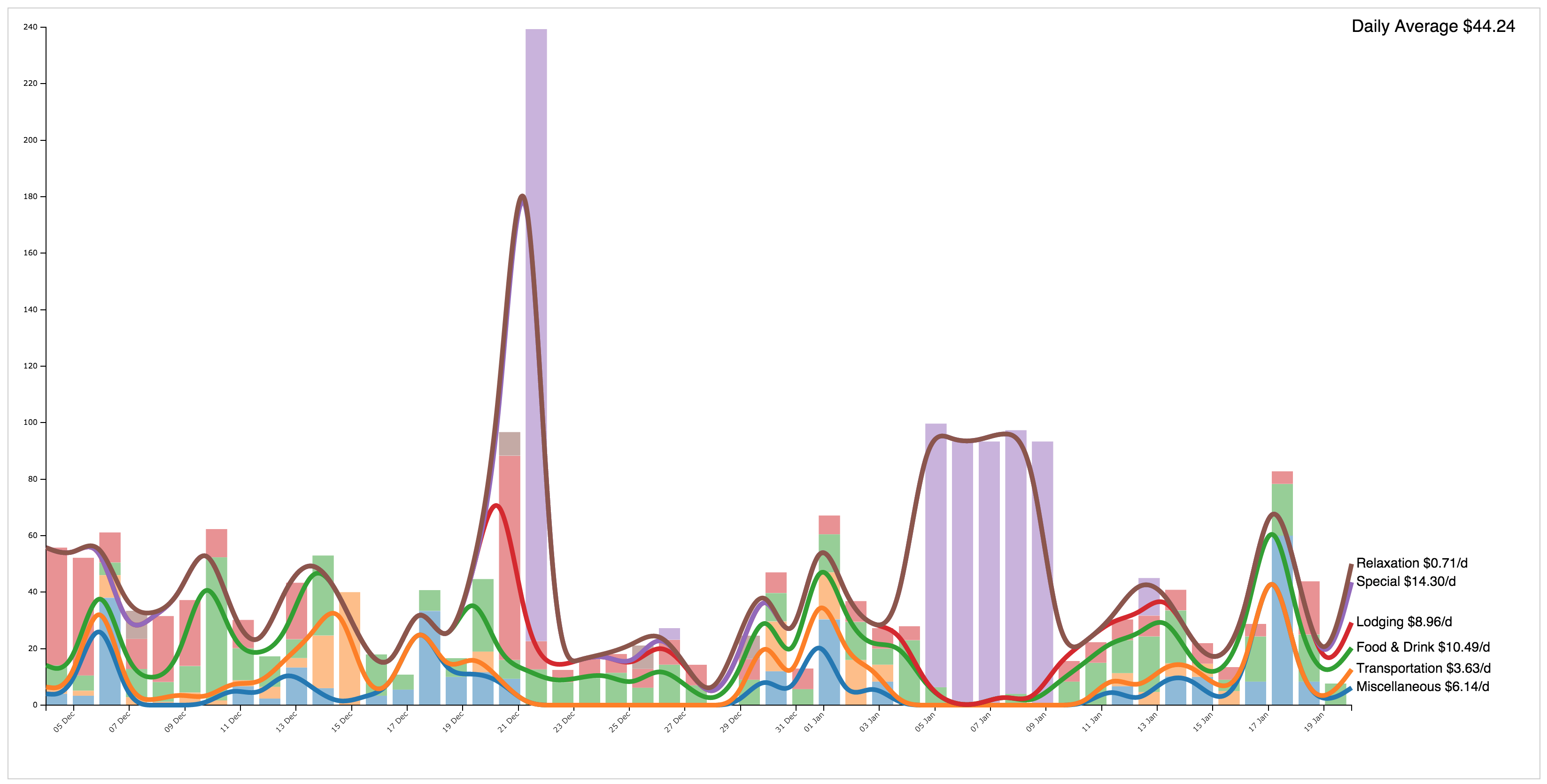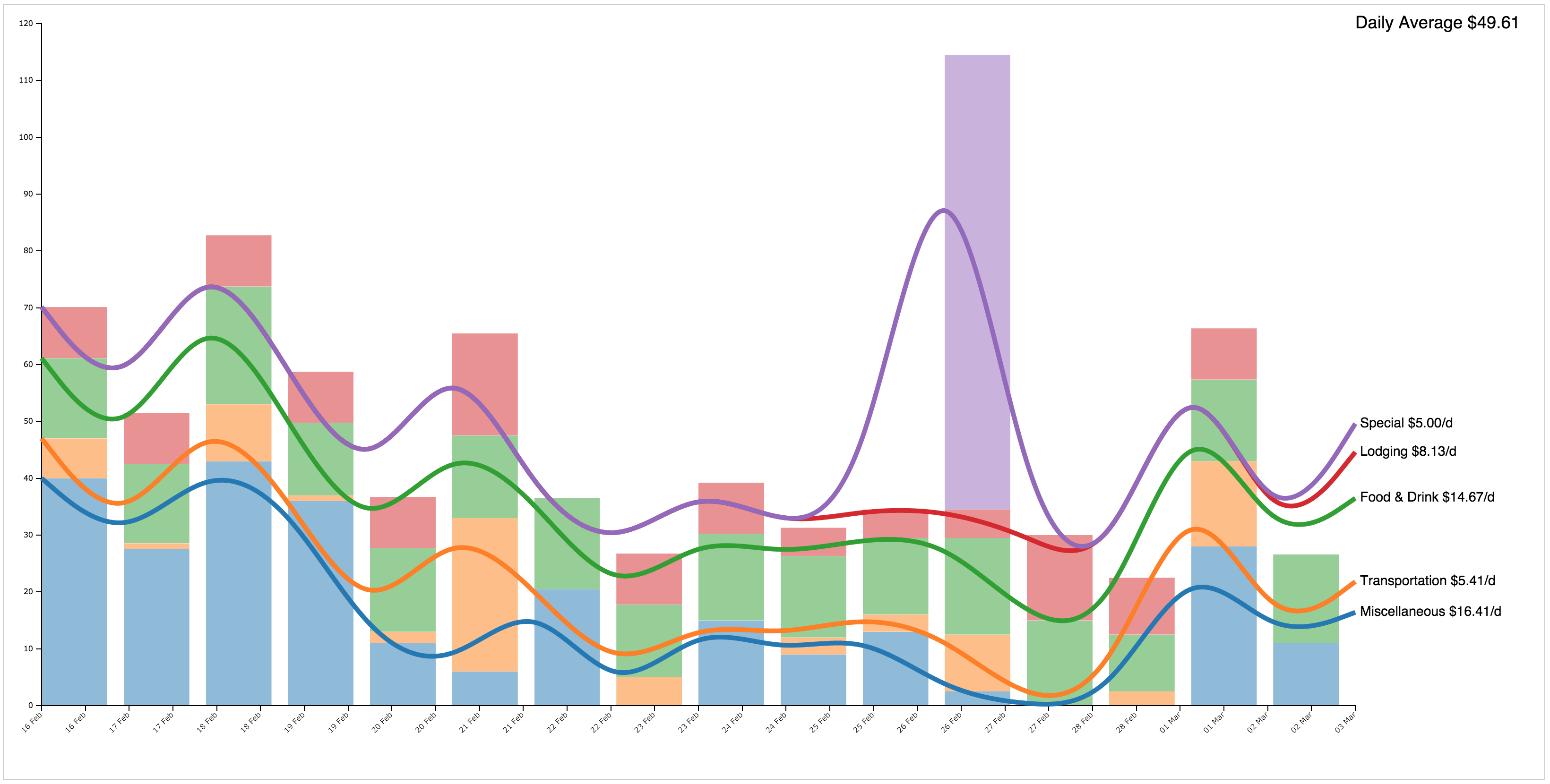Costs of Living

You must be rich to travel. You must wait until you have enough money to retire, then you can roam about the world freely. Short vacations only till then. Perhaps that’s what you think. That’s what I thought, anyway.
Two visions of my ‘gap year’ have been co-existing in my head: a big long vacation before going back to the old life, or a new beginning. As my feelings shifted more to the idea that living as a nomad is more than a brief dalliance, money became more critical. There’s a big difference between an extravagant adventure funded by the savings of 15 years of labor and a sustainable lifestyle. Stories of inexpensive trips to southeast Asia abound, but I’d never done anything like this before. Would hostels prove too gross? Would security concerns force me upmarket?
So I headed off with a $50 a day budget 1 and no experience. Did I hit my goal?
No. But it was pretty close. $4908 for 90 days — December 3 to March 3 — of travel or $54.53 a day 2. It’s clear to me that it’s entirely possible to keep to that budget as I’ll explain at the end.
Here are the things that pushed me over budget:
- Expensive indulgences The massage school, the yoga retreat in Pai, the climbing tour and the dive sessions were all in the hundred(s) of US dollars range. Even though they included some food and in the case of the retreat, lodging, they were each multiple days’ budget each. These were such outliers I categorized them as ‘special’ to be able to quickly see the totals with and without them.
- Angkor Visiting the Angkor area is not cheap: $40 for the 3 day pass alone, and then you add in the cost of tours.
- Yoga I felt a growing interest in yoga throughout my trip. Funding that interest was between $5 and $12 a day, most typically $8.
- Visas Easy to forget, but Indonesia required a $35 entry visa and Cambodia a $30 one.
- Traveling in Pairs In Bali, the accounting becomes complicated. Melissa had a ‘free’ home exchange we used for part of the trip and we paid for the bungalow in Amed. Some meals were doubled. It’s impossible to disentangle the finances and find a ‘true’, one person, average.
I categorized the (1) expenses as ‘Special’. Without them, the total drops to $3747 or $41.63 a day.
Now from my previous perspective these are almost laughable expenses. Thoughtless Amazon Prime one-click ordering costs. But they each are significant chunks of one of the daily budget or multiples of it. The ‘normal’ days are not so inexpensive that they make up for these treats.
Pretty Pictures
In a flashback of my previous work life — and perhaps a foreshadowing of a new freelancing career — I created a visualization of the costs (and wrote about the design on my technical blog here). I kept fairly obsessive track of my spending (there are innumerable line items like ‘gum’ and ‘water and peanuts’) and they combine to provide a detailed account of all my spending.



Observations
- Thailand was the least costly Northern Thailand in particular, but even Bangkok was relatively inexpensive. In the case of Pai, very inexpensive. Especially the food, where local restaurants were both very tasty and an incredible value at around ฿40 (about $1.25) for a meal.
- Tourist Areas are Costly Siem Reap stands out, but Ubud and Sihanoukville were quite costly. Phnom Penh was also shocking. In particular, though you could often find a bed for under $10 a night, food costs could be very high in these places, as in > $5 a meal.
- Transport in Bali was very costly. Getting to anywhere from anywhere involved hiring a car, usually for 600000 IDR or about $50. Even split two ways, this is a lot of money. It’s reflected in the averages: per-day transport costs in Bali were twice those elsewhere. Only at the very end did I begin to take busses instead.

Limbo
Getting under the budget including airfare and the occasional ‘Special’ cost would entail getting more rigorous about the daily spending habits:
- Choose the Place Northern Thailand was the least costly place I stayed. It was possible to spend < $25 in Pai on normal expenses.
- Stay Longer The longer I stayed somewhere, the cheaper it got. Finding local places to eat, avoiding the costs of travel, etc…
- Avoid the Tourist Areas To most locals in the tourism industry, I look exactly the same as a vacationer coming in for 10 days and then back to a job. For such a person $50 is a pretty insignificant amount of money. Places like Siem Reap are geared towards such people. And while its possible to spend less in these places, it takes more work; there’s a lot more temptation.
- Stay Busy A volunteering option or other way to fill your days will help. Not only can you get lodging ‘for free’, but you remain away from the temptation to spend.
So that’s it. I’ve proven to myself that inexpensive travel is totally doable and comfortable enough for me. My first effort was very close to the mark and it seems pretty easy to do better. This is true freedom! It’s wonderful to realize how little it takes to give you the experiences really value, especially when you thought them luxuries.